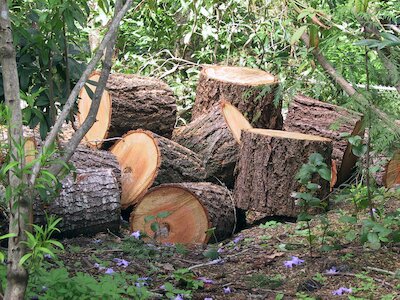How Tall Should A Firewood Chopping Block Be?
It is a matter of personal preference. But if I were to put out a number, it would be about 16 inches (40.7 cm) long.
16 inches is the standard round size (this is a term for logs that have been cut to size; the wood you’ll actually split). So all you would really need to do is pick out one that is big enough.
Gnarly, twisted and otherwise hard to split wood makes best chopping blocks, as it can withstand the ever so often glance of the maul, and general wear and tear.
Having said all that, and as I mentioned in the first paragraph, the actual height much depends on ones wants and needs.
But I think we should begin this battle of opinions by talking whether you need a splitting block at all to begin with.
Chopping block or no chopping block? That is the question
You don’t need to use a wood splitting block to process firewood.
In this case, what many choose to do instead is work the rounds right where they sit on the ground.

“Firewood” by Mom the Barbarian is licensed under CC BY 2.0
Why would a person do this instead? Well, what this achieves is, what we call in the wood burner community, removes a touch.
You should, in a perfect world, try to touch wood as little as possible in your whole firewood process, from begging to the stove.
And not needing to lift a round to place on a chopping block removes that so called touch.
Sounds a bit smart, I know, but think about it this way – why do all that lifting when you can leave the wood where it stand and do essentially the same thing?
Then you have to consider the pieces that go off to the sides when, let’s say, you halve a round. You have to then take those pieces, put ’em up on the splitting block and have at it again. Seems like too much bending and lifting to me.
When you halve a round when it’s on the ground already, sure you may need to reach in to prop the pieces that went to the side (unless you use the tire method), but you can easily do that with something like a hookaroon.
And let’s not even get started on the fact that some wood rounds may be just too heavy to lift on a chopping block to begin with, so the only option left becomes chopping it up on the ground anyway. Certainly something to think about.
More force?
But wait, there’s more. The icing on the cake, I think, is the extra travel distance your splitting maul, axe or what have you gets from splitting those rounds on solid ground.
And yes, we could delve into long winded conversations about how its actually the opposite – the ground does seem to suck up more of the impact than the wood when you split it without the use of a chopping block.
Look, I’m not a scientist to put this theory to the test, but at times I did whack my wood right where it sit on the ground, I did have more of a pop to my swing.
Doesn’t come without drawbacks
When you swing a maul without a round underneath, you will end up running it into the ground more often – this happens when it goes through like butter and digs into the soil, glances off and does the same thing, etc.
This will inevitably dull the edge quicker. But it doesn’t have to be that sharp to begin with – you’ll just have to hit it with a file every so more often. Good thing I’ve written a blog post about the exact same thing.
Another thing to think about is the soil quality. If it’s muddy, the rounds are going to end up getting messy, burying into the ground and becoming hard to work with. Not too much of a problem if you aren’t afraid of getting a little dirty, if you ask me.
Why not both?
So if having a longer swing is seemingly a better idea, though having a solid base is too, why not combine these things into one?
Shorten a chopping block to about 8 inches, and you have best of both worlds, well, in terms of range of motion.
You’ll still need to pick up a round of your choice to place on a block, it’s just now you will have more of a swing behind it.
With that said, I’ve read of a few people who cut a stump very close to the ground and used that as a “chopping block” instead.
Best of both worlds if you ask me, but not a possibility for most of the folks out there.
A chopping block is always a good idea when you have to work with smaller in diameter firewood.
Small rounds, if you can call them like that, are hard to split without a solid underneath. So really, that’s the perfect example of when having a proper block at hand is not that bad at all.
Or you halve a bigger round or so and want to divide the rest of those pieces up – then placing all that on a stable chopping block will make easy work.